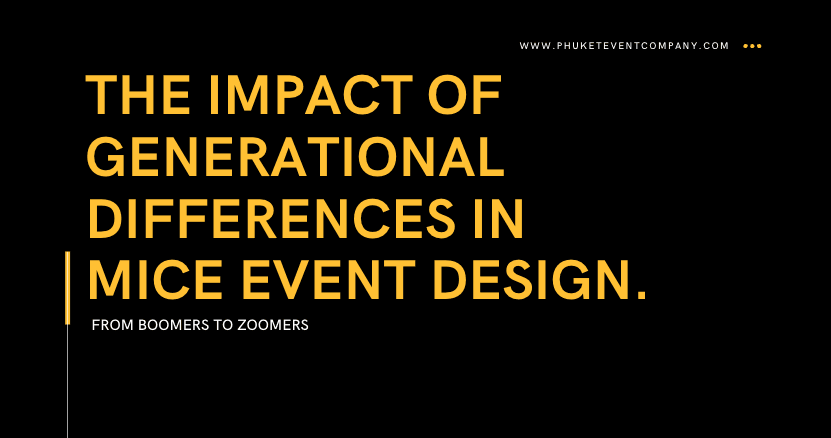The Impact of Generational Differences in MICE Event Design.
The impact of generational differences on (Meetings, Incentives, Conferences, and Exhibitions) MICE event design. With the modern workforce becoming increasingly diverse, it is important for event planners to take into account the unique preferences and expectations of attendees from different generations.
The four generations that make up the modern workforce, and provides insights on how their preferences for technology, communication, and content can impact the success of MICE events. The article also offers tips for event planners to create events that resonate with attendees from different generations.
As the global workforce becomes increasingly diverse, MICE (Meetings, Incentives, Conferences, and Exhibitions) event planners must take into account the impact of generational differences on event design.
Different generations have unique preferences, expectations, and communication styles, which can impact the success of MICE events. In this article, we will explore the impact of generational differences on MICE event design and provide tips for event planners to create events that resonate with attendees from different generations.
From Boomers to Zoomers: Navigating Generational Differences in MICE Event Design
The Four Generations
Before diving into the impact of generational differences on event design, it is important to define the four generations that make up the modern workforce:
- Baby Boomers: born between 1946 and 1964
- Generation X: born between 1965 and 1980
- Millennials: born between 1981 and 1996
- Generation Z: born between 1997 and 2012
Each of these generations has unique characteristics and experiences that shape their preferences and expectations for MICE events.
Impact on Event Design
The impact of generational differences on MICE event design can be seen in several areas, including technology, communication, and content.
- Technological familiarity: A key distinction among generational groups lies in their ease of use with technology. Individuals from the Millennial and Gen Z cohorts have been exposed to technology from a young age, frequently being referred to as “digitally native.” In contrast, people from the Baby Boomer and Gen X demographics might not feel as at ease with technology. Event planners should take into account attendees’ technology preferences when designing MICE events, including offering Wi-Fi, mobile apps, and interactive technology during sessions.
- Communication: Each generation has unique communication styles, which can impact the success of MICE events. Baby Boomers and individuals from Generation X might have a proclivity for more formalized and organized forms of communication, whereas those from the Millennial and Gen Z cohorts might lean towards informal and engaging interactions. It is important for those coordinating events to be mindful of these tendencies when devising communication strategies, such as email initiatives, social media promotions, and in-person communication.
- Content: each generational group has distinct inclinations concerning content and learning methodologies. Individuals from the Baby Boomer and Gen X groups might find conventional lecture-based presentations more appealing, while those from the Millennial and Gen Z demographics might have a preference for dynamic and experiential learning opportunities. Keeping this in mind, event organizers should tailor session themes and structures to cater to these inclinations, incorporating chances for attendees to engage in collective activities and practical workshops.
Tips for MICE Event Planners
To create MICE events that resonate with attendees from different generations, event planners should take into account the following tips:
- Offer a variety of technology options, including Wi-Fi, mobile apps, and interactive technology during sessions.
- Present an assortment of session themes and structures, encompassing conventional lecture-based presentations, dynamic discussions, and practical workshops.
- Facilitate chances for attendees to interact and establish connections with one another, including during intervals and post-event gatherings.
- Incorporate diverse communication methods, such as email initiatives, social media promotions, and in-person interactions, to connect with participants across various age groups.
- Consider the preferences of each generation when designing event branding, including logos, colours, and messaging.
As the global workforce becomes increasingly diverse, MICE event planners must take into account the impact of generational differences on event design. Each generation has unique preferences, expectations, and communication styles, which can impact the success of MICE events.
By taking into account attendees’ technology preferences, communication styles, and content preferences, event planners can create events that resonate with attendees from different generations. Offering a variety of technology options, using a mix of communication styles, providing a variety of session topics and formats, and offering networking opportunities are all important steps in designing successful MICE events for a diverse audience.
Ultimately, by understanding and catering to the needs of each generation, event planners can create memorable and effective events that leave a lasting impact on attendees.

